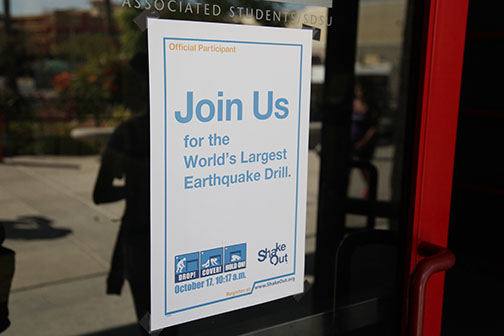
On Thurs. morning, Oct. 19, San Diego State participated in the Great California Shakeout, an annual statewide earthquake drill meant to prepare Californians for an actual quake.
Director of Emergency Services Lamine Secka said one of the main goals of the drill was to test SDSU’s emergency notification system, SDSU Alert, where students who are signed up for the alert system receive text messages or emails during an emergency.
Secka said that although it is hard to tell whether students are equipped with the proper knowledge on what to do during an earthquake, he believes that most students have a fair idea on what earthquake protocol is.
“I know most of our students have gotten earthquake drills and preparedness all through school up until this point, so hopefully they bring that knowledge with them,” Secka said. “They do a lot of preparedness discussions and conversations in the residence halls, and so this (drill) can just serve as a reminder.”
However, liberal studies junior Emily Zora believes SDSU could improve in informing its students on drills.
“I don’t think SDSU is very effective in teaching the protocols, especially since I didn’t even know about the earthquake drill, since I am a commuter student,” Zora said.
Despite this, Zora said that after taking a course in geology, which discussed earthquakes and proper protocol, she feels assured in her knowledge and prepared if an earthquake were to hit, stating that her first instinct would be to take cover under a desk, or any other sturdy surface.
The ability of the San Andreas fault to cause a major earthquake in Southern California had been a concern in the region for decades.
Victor Camp, professor in geological sciences who specializes in volcanology and teaches a course in natural disasters, said that San Diego, based on its geographic location, would not be as severely affected if an earthquake were to hit on the San Andreas Fault, because it lies so far east from San Diego.
“It’s far enough away from San Diego that most of the effect won’t be felt here in San Diego, even if it’s a large earthquake,” Camp said. “It’d be felt more in the Los Angeles Basin.”
The San Andreas Fault has quite a bit of build up stress however, Camp said, so San Diego would definitely feel some of the effects if there were to be a major earthquake.
“There have been some earthquakes (on the San Andreas Fault), but not enough to release the amount of stresses built up over time,” Camp said.
Also, San Diego does have a fairly active fault line, the Rose Canyon Fault, which Camp said has the ability to produce a magnitude 7 earthquake, although the U.S. Geological Survey estimated that there is a small probability of a major earthquake on Rose Canyon Fault in the next 30 years.
If an earthquake were to occur, Camp said that the general rule is to be careful when running out of a building, because there is always a risk of buildings collapsing and windows breaking.
“The best thing you can do is try to find a place within the building that you’re in that is protected as much as possible, (like) a desk,” Camp said.






